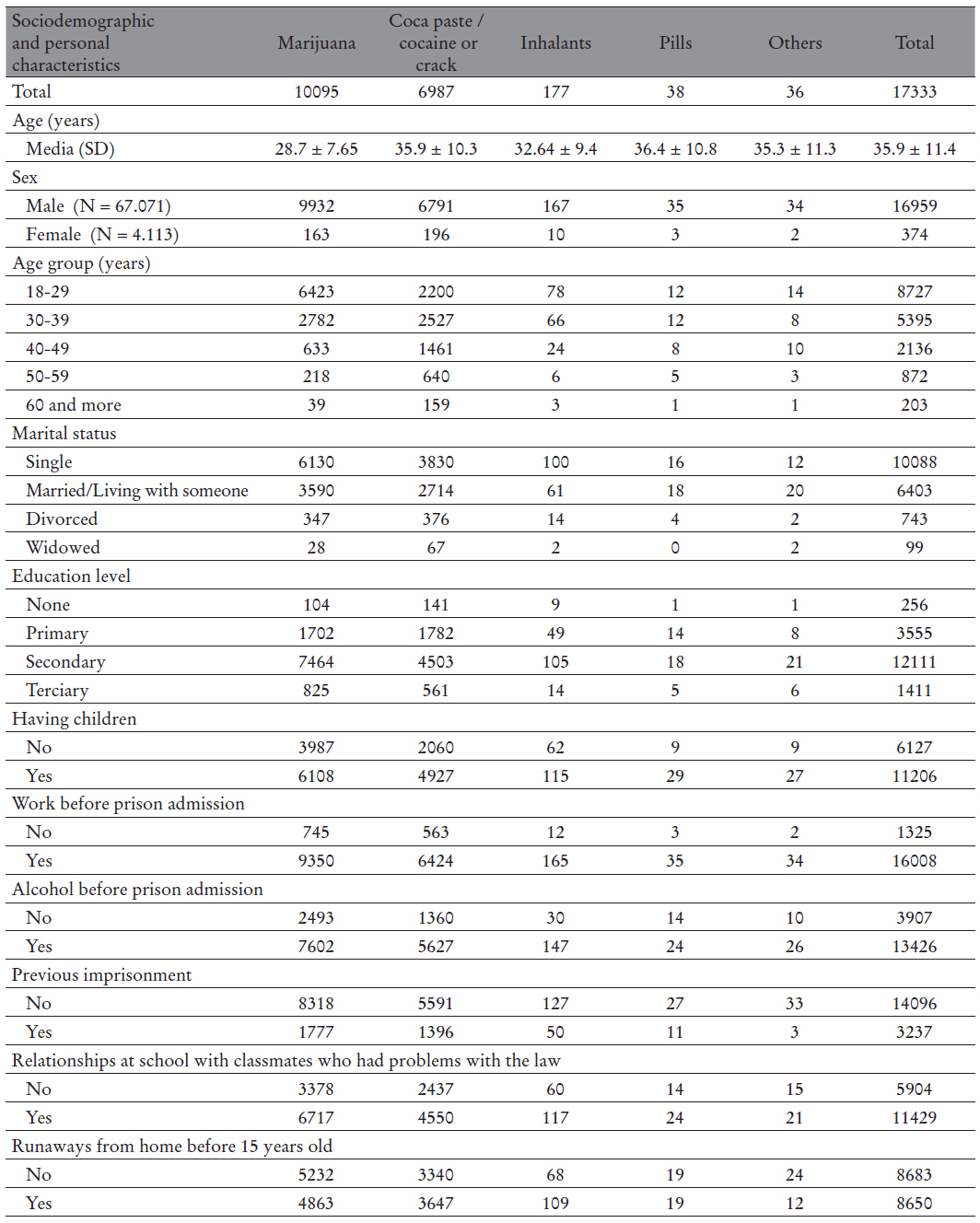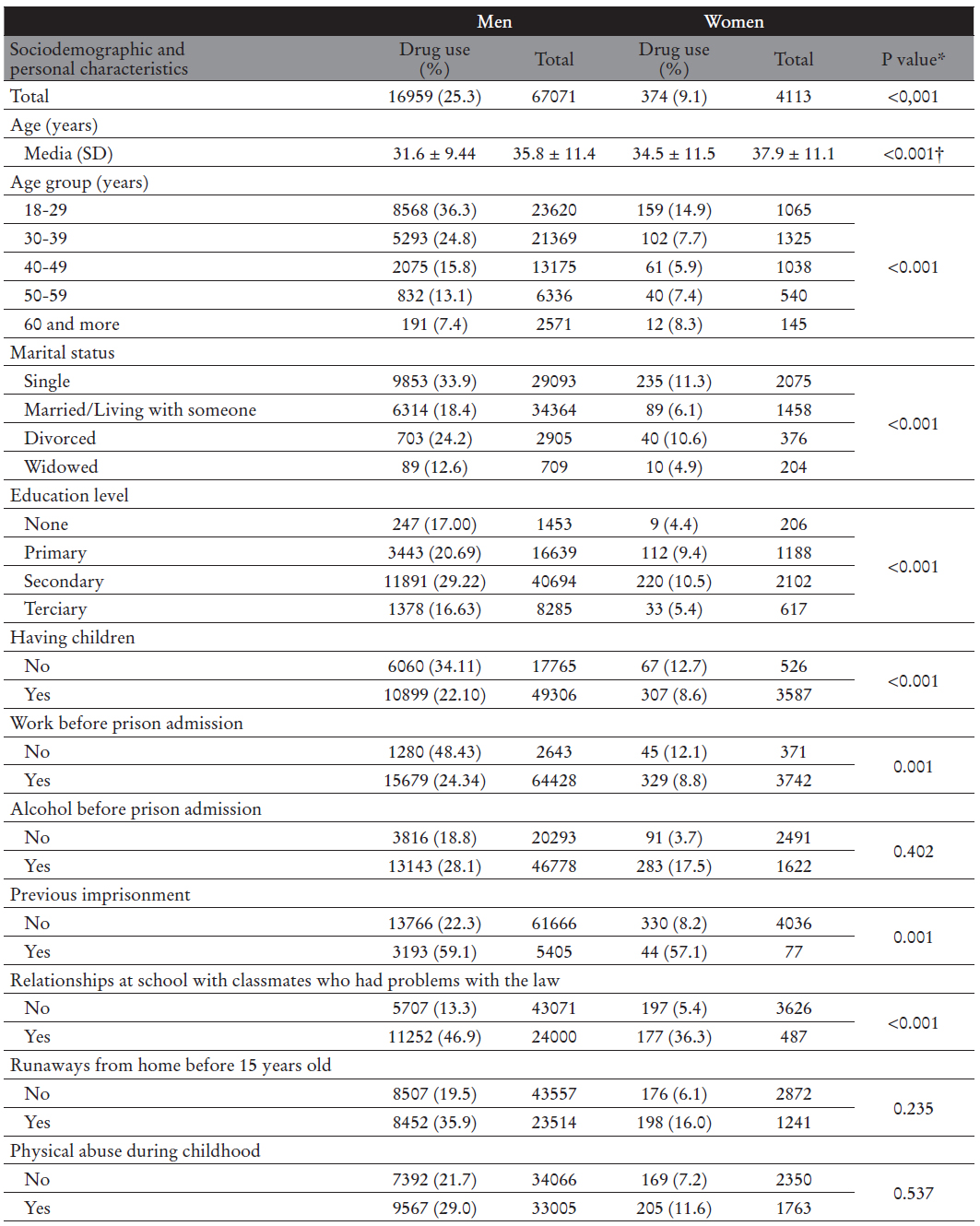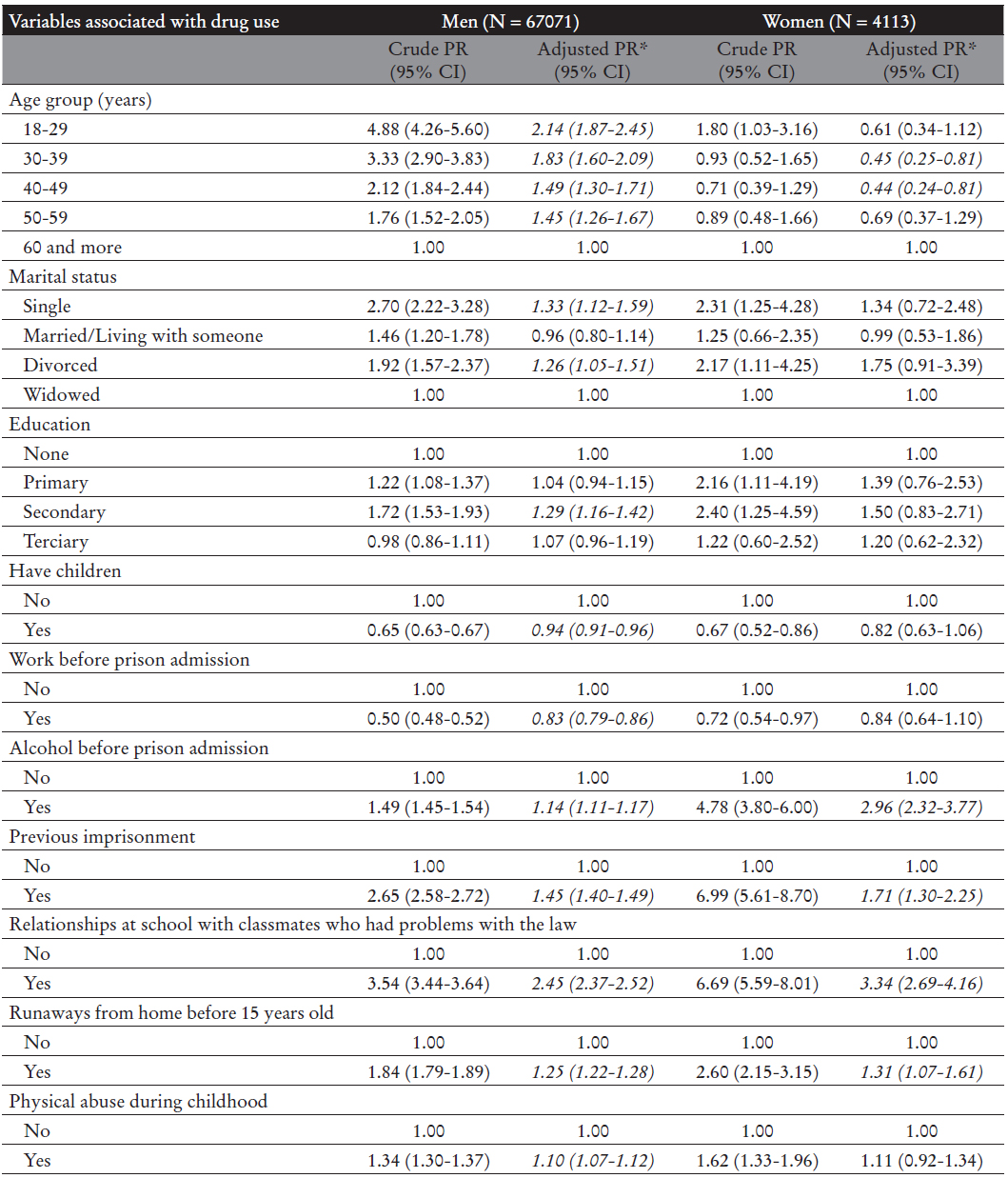INTRODUCTION
Drug and alcohol abuse are the major risk factors for the loss of disability-adjusted life years (DALYs) in youth1. It is estimated that about 250 million people between the ages of 15 and 64 consumed drugs in 2014, which is associated to approximately 43.5 deaths per million people worldwide2. One of the groups most prone to drug use is the penitentiary population, among which a higher consumption of other psychoactive substances such as tobacco has been reported3, with a prevalence of consumption in men up to ten times higher than the general population4. The close relationship between drug abuse and crime is one of the main problems in many penitentiary facilities, where the prevalence of drug use ranges from 50% to 79%5,6. The high incidence of crime in Latin America has been fol-lowed by the growth of the penitentiary population7,8. However, conditions in prisons are not adequate in most countries. They are associated with a lack of security, deteriorated infrastructure, overcrowding and violence within them, which could generate favorable conditions for the use or intensified consumption of drugs8,9. Despite the high prevalence of drug abuse, the prison population has limited access to prevention, treatment and rehabilitation options, making it difficult for prisoners to be reintegrated into society5,10,11.
The distribution of the penitentiary population by sex shows significant differences. Women represent 2 to 9 % of the world’s prison population, and 3 to 12 % in Latin America; among them the most common crimes are drug trafficking and commercialization, while in the male population they are more violent crimes7,8,12. Risk factors associated with the use of psychoactive substances have been identified, such as poverty, low educational level, unemployment, physical violence or antecedents of prior consumption. However, some of these factors have a differential distribution between men and women13-15.
In Peru, the First National Prisoner Census 2016 (known in spanish as PCNP) was held in 2016, which included questions related to drug use of the entire prison population, which will serve as a source of information to evaluate factors that could be related to drug use and crime in the country16. In this particular case, the objective of this study was to determine the prevalence of drug use prior to penitentiary admission and to identify associated sociodemographic and family risk factors, according to gender, in penitentiaries in Peru.
MATERIALS AND METHODS
A secondary analysis of the PCNP 2016 was carried out, which took place in Peru from April 19 to 26, 201616, conducted by the National Institute of Statistics and Informatics (known in spanish as INEI) in coordination with the Ministry of Justice and Human Rights, and the National Penitentiary Institute (known in spanish as INPE). The PCNP 2016 was a questionnaire with 173 items (previously validated and applied to a pilot test in two penitentiary establishments to a total of 30 inmates) that was applied to the entire population of the 66 penitentiary (all) establishments in Peru. The objective of the census was to obtain statistical information on the adult prison population that would serve as a basis for the development of public crime prevention policies aimed at reeducation, rehabilitation and reintegration of the prisoner into society. The information was collected by interviewers trained by direct interview in a data collection system installed in a mobile device (tablet) that also contained a program of control of ranges, flows and validations16.
In this analysis, the types of drugs used before admission were analyzed according to features of the penitentiary population. In addition, in order to identify the factors associated with consumption, drug use before admission to the penitentiary establishment was considered as a dependent variable for both men and women.
The independent variables (individual, family and social) considered were: age, marital status, educational attainment, having children, employment status before admission, alcohol consumption prior to admission, history of confinement, relationships in school with others who have problems with the law, running away from home before age 15, physical abuse by a family member during childhood (5 to 12 years), having a family member who used drugs in childhood, or a family member with a history of admission to a penitentiary.
The databases were obtained from the INEI web portal (http://iinei.inei.gob.pe/microdatos/) and data analysis was performed using Stata® v14.1 software (Stata Corporation, College Station, Texas, USA). In a first stage, the characteristics of the population were described by absolute frequencies and percentages for each gender. The second stage consisted of a bivariate and multivariate statistical analysis; using Generalized Linear Models (GLM) of the Poisson family and log link function to determine the association between drug use before confinement by gender and individual, family and social variables. For the multivariate analysis, we included those independent variables that showed a significant association with the dependent variable and reported prevalence ratios (PR) with 95% confidence intervals (95% CI), considering a p value <0.05 as statistically significant.
The conduct of this study did not require the approval of an ethics committee because it was an analysis of secondary data that were obtained from a public domain and free access that does not allow the identification of surveyed subjects or their penitentiary centers.
RESULTS
Of the 76,180 prisoners, complete information was obtained from 71,184 (93.4% response rate) that were included in the analysis. According to the distribution of the penitentiary population, men accounted for 94.2% (67,071) of the total and the average age was 36 years (standard deviation, SD 11.4) for men and 38 years (SD 11.1) for women. The most frequently used drugs were marijuana (58.2%), coca paste/cocaine or crack (40.3%) and inhalants (1%) (see Table 1). The overall prevalence of drug use before admission was 24.4% (25.3% in men and 9.1% in women), with the highest prevalence in the 18 to 29 age group (36.3% in men and 14.9% in women).
Table 1 Key features of the penitentiary population and type of drugs used before imprisonment in Peru, 2016.


Note. SD: Standard Deviation
According to sociodemographic characteristics of the male prison population, unmarried prisoners (33.9%), without children (34.1%), with an average educational level (29.2%) and unemployed (48.4%), reported a higher frequency of drug use before admission to the prison. Within the family characteristics, those who suffered physical abuse during childhood (29.0%) had a family member who consumed drugs (59.8%) and background of a family member who was imprisoned (38.4%) reported higher consumption rates.
With respect to individual and social characteristics, the same was observed in those with a history of previous imprisonment (59.1%), relationships at school with classmates who had problems with the law (46.9%), and a history of running away from home before age 15 (35.9%). Likewise, these charac teristics were those that presented a higher frequency of self-report of drug use in women. Table 2 shows the frequencies of each of the variables studied according to drug use in men and women.
Table 2 Characteristics of the penitentiary population and prevalence of drugs used before by sex in Peru, 2016.


Note. SD; Standard Deviation *Chi-squared. f Student’s T Test.
Table 3 presents the results of the regression models with their crude and adjusted PR. In the bivariate analysis, all variables showed a statistically signi ficant association with drug use before admission to the penitentiary center for both men and women.
Table 3 Factors associated with drug use before prison admission in the penitentiary population of Peru by sex, 2016.


Note. 95% CI: 95% confidence interval; PR: prevalence ratio.
*Adjusted for all the variables statistically significant in the crude analysis. PR in bold type are statistically significant (p < 0.05).
In the multivariate analysis it was observed that in men, relationships with school classmates who had problems with the law (PR 2.45, 95% CI: 2.37-2.52), the age group from 18 to 29 years (PR 2.14, 95% CI: 1.87-2.45) compared to the population aged 60 years or older, history of previous imprisonment (PR 1.45, 95% CI: 1.40-1.49), and having a family member who consumed drugs (PR 1.40, 95% CI: 1.35-1.46) were the variables significantly associated with a higher probability of drug use. Likewise, having children (PR 0.94, 95% CI: 0.91-0.96) and being employed before admission (PR 0.83, 95% CI: 0.79-0.86%), were significantly associated with a lower probability of drug use before admission to the penitentiary (see Table 3).
On the other hand, the multivariate analysis for women showed differences compared to men. It was found that relationships at school with classmates
who had problems with the law (PR 3.34, 95% CI: 2.69-4.16), alcohol consumption (PR 2.96, 95% CI: 2.32- 3.77), having a family member who consumed drugs (PR 2.31, 95% CI: 1.75-3.04) and history of previous imprisonment (PR 1.71, 95% CI: 1.30-2.25), were factors significantly associated with a higher probability of drug use before admission to the penitentiary. Likewise, being between 30 and 49 years old compared to women aged 60 and over is associated with a lower probability of using drugs. Marital status, educational level, having children, employment status, and family violence during childhood did not show a significant correlation (Table 3).
DISCUSSION
This analysis, when covering the entire penitentiary population of the country, has the strength of a sample size which is equivalent to a census rather than a sample. The survey in many cases refers to events that occurred in childhood. It is therefore possible that the results may be affected by the reliability of the information associated with biases of memory. Additional limitations apply to potential misunderstandings of the questions about “alcohol consumption”, for example, or even “drugs” (although the questionnaire specified marijuana, inhalants, paste/ cocaine or crack, pills or “other type”). Owing to its cross-sectional design, it is possible to find associations, but temporality or causality are impossible to establish. Thus, it is not possible to determine whether drug use precipitates criminal behavior, whether antisocial personality favors consumption, or whether other personality factors may favor criminal behavior or substance abuse17.
The main findings of this study indicate a marked difference by gender in the prevalence of drug use before admission to a penitentiary center, with a prevalence in males almost three times higher than females (25.3% and 9.1%). However, this difference is less than that reported in a systematic review, which found averages of consumption of 10 to 48% in men and 30 to 60% in women4. According to the type of psychoactive substance consumed before prison, we found that the most consumed substance is marijuana in men and the paste/cocaine or crack in women. Likewise, among the risk factors, there are also differences according to sex related to age, marital status, educational level, parenthood and physical abuse in childhood. These differences should be considered in the planning process of rehabilitation and social reintegration measures in this population group.
The prevalence of consumption before admission to the penitentiary (24.4%) was twice as high as the prevalence in the general Peruvian population or in the country’s capital18,19. However, this prevalence is less than that reported in the penitentiary population of other countries in the region, such as Argentina (64.4%), Chile (83%), Colombia (37.6%) and Ecuador (33.9%)20.
One of the objectives of incorporating questions on mental health in the PCNP was to contribute to the design of specific prevention strategies, control and rehabilitation of drug abuse16. This work identifies some subpopulations, such as the penitentiary population, which could have determinants for the consumption of drugs. Many of these may be modifiable to a certain extent, such as environment and socio-family relations21,22. In this population, the lack of prevention or timely treatment in prison admission or later would generate the continuity of the addiction23.
It is an interesting finding that one of the factors associated with a greater probability of drug use, both in men and women, were relationships at school with classmates who had problems with the law. Although we did not find specific studies that related this fact to the use of drugs in prisoners, there is evidence on how an adverse school environment is associated with behavioral problems and a greater propensity to commit crimes in the future24. On account of this, schools have a key role as a space of prevention, since they would have the opportunity to identify and handle cases of children with risk behaviors, and thus avoid future criminal behavior not only in them but also in their peers.
Alcohol consumption in women was found to be a factor associated with three times the consumption of drugs prior to prison admission. In low- and middle- income countries, such as Peru, it is where the most severe health risks for health are registered25,26, especially in women27, which supports studies that report higher prevalence of alcoholism in the female prison population28. In this manner, taking into account our results, alcohol consumption could eventually lead not only to the consumption of other substances (without causality), but also to social inequality can lead to a rise of antisocial behaviors such as violence and criminal behavior29. At the same time, the finding that unemployment is associated with substance use prior to penitentiary admission is not surprising, since there is a clear relationship between unemployment and low socioeconomic status with drugs and alcohol30,31. Considering that in the most disadvantaged social groups the negative impact of the consumption of psychoactive substances is greater32, public policies that target multilevel interventions should be implemented.
On the other hand, some characteristics of or experiences during childhood could have different impact on men and women in the consumption of drugs as well as on the probability of going to prison. It was found that having a family member who consumed drugs and personal history of runaways before age 15 had a similar influence on both sexes, whereas physical abuse seemed to affect men more. These positive associations are consistent with an investigation carried out in Mexican prisons. Although this investigation did not establish differences according to gender, it reported that living with an adult drug user as well as history of runaways from home were the major familiar factors during the childhood associated with drug abuse before being a criminal33.
According to our study, another factor associated with drug use is having, during childhood, a family member who was admitted to prison (with a greater effect on women). In this regard, although our results show that this factor increases the probability of consumption, a systematic review indicates that imprisonment causes many difficulties for the families and children of prisoners with an increase in the risk of antisocial behavior in adulthood, but not for mental health problems, drug use, or low school performance34. Experiencing these difficulties added to multiple negative emotions during imprisonment could develop or persist in the long term and lead to the commission of crimes in adulthood, so prison policies and programs should also prevent the conse quences of imprisonment in close family35.
Other important differences that we find are having children and having worked before entering the penitentiary. In women, these factors show no association. However, in men, we observed that these factors are protective in decreasing the probability of drug use. These findings support those of studies in the Mexican prison population in which both characteristics are associated with lower probabilities of drug use33, and with a study in Spanish penitentiaries, that also reports unemployment as a predictor of consumption of psychoactive substances5.
In conclusion, our study found that there are differences according to gender in the prevalence of drug use and its associated factors before admission to a penitentiary. By order of prevalence, men reported having previously used marijuana, coca paste/cocaine or crack and inhalants, and women reported used of coca paste/cocaine or crack, marijuana and inhalants. Likewise, events in childhood such as abuse, having a family member who was imprisoned or used drugs, or having consumed alcohol during childhood are important and differentiated factors that must be considered. The complexity and adversity of the penitentiary context, as well as the presence of associated factors of drug use, which in some cases originated in childhood, demonstrate the need to implement community interventions in mental health by authorities to prevent drug use and crime. Likewise, it is important that these interventions, as well as the design of social and health policies, should be focused on specific subpopulations, taking into account the social and family context, and in relation to the type of substance consumed (alcohol, marijuana, coca paste/cocaine or inhalants).














